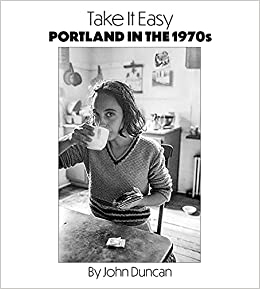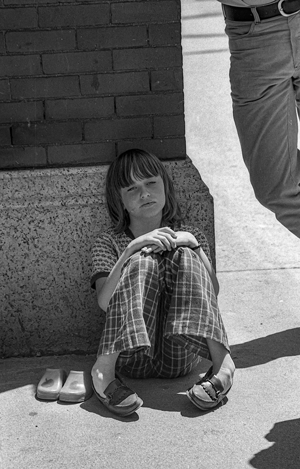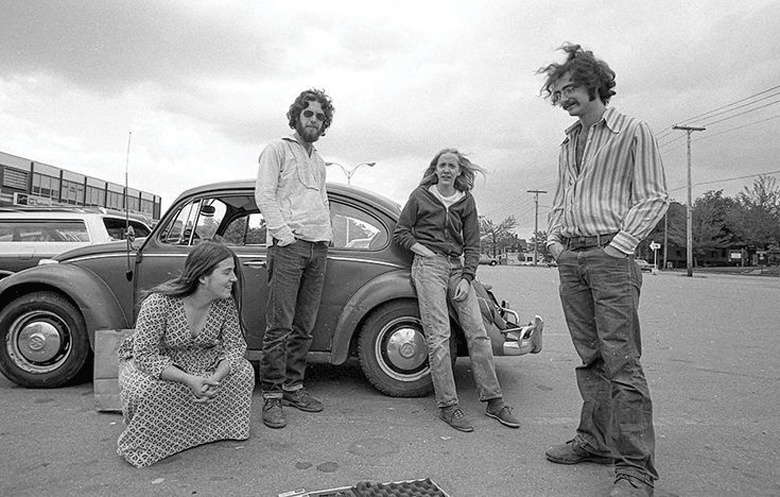Take It Easy: Portland in the 1970s
by John Duncan; Islandport Press
Review by Dana Wilde
Summers in the ’60s my father trundled from Cape Elizabeth to Portland to go to marine chandleries on the wharves. I remember Commercial Street being like something out of a badly filmed B movie.
When you got down onto it from York Street, the concrete arches of the Million Dollar Bridge were suddenly high above you, and in the shade and litter underneath were weedy refuges for homeless drunks. On hot days a dusky, rancid stink permeated the riverfront arising from the fish meal plant, a huge, looming, gray metal building that’s long since disappeared.

The roadway was made mainly of cobblestones that rattled the car and your bones. Used and useless railroad tracks crissed and crossed at angles unrelated to the directions vehicles were driving. With no clear lanes to stay in, cars and trucks veered all over trying to avoid the obstacles, which included each other. I don’t know how many times the car I was in steered to the left of oncoming traffic instead of to the right on Commercial Street in the ‘60s and into the ‘70s.
She seems melancholy, beaten down. But also neatly attired, with crisply cut bangs…
In 1974, the I-295 spur off the Turnpike opened, letting traffic onto Franklin Street Arterial directly to Commercial Street. The Old Port by then was transforming from seedy waterfront dive neighborhood to nascent mini-Greenwich Village North. Artist studios, book stores, restaurants, bars, shops, music, poetry readings, a street festival that started in 1973.
The creative energy in Portland in those days seemed so prevalent that phrases like “Paris of the ’70s” arose on the streets. It could have been a naive delusion of grandeur suffered by youth flush with aspirations; and now, mere nostalgia. But when you look at John Duncan’s photos, you get the feeling Portland’s ’70s were a moment of moment after all.
Duncan, who grew up in Falmouth, shot the photos in Take It Easy: Portland in the 1970s with random abandon around town, often from the taxicab he drove all over the peninsula and elsewhere. The faces, places, and smallest details in his images vibrate with energy.
If you spent much time on the streets, you crossed paths with performer Reggie Osborne, musician and clothier Beth Blood, bespectacled, skinny-necktied photographer Chris Grasse—their faces are perfectly imaged in Duncan’s photos. The young woman on the cover, Dust, you either knew or had heard hilarious stories about, in scrappy kitchens exactly like the one where she’s sipping coffee.

Congress Street from Monument to Longfellow squares was still the main commercial drag, and Duncan’s photos show exactly what and who it looked like.
Porteous, Recordland, the Hay drugstore, Paul’s Foods, the dignified elderly pedestrians of Congress Square. Cathay Garden. Boys in front of the library in the Baxter Building crowding next to Bruce Holsapple’s poetry easel, where he sat days purveying theories of art.
The rough and tumble Rook and Pawn, the scroungy Spring Street bus station. Pizza Villa. A skyline view from Munjoy Hill. Sun-beaten Fowler’s Beach on Long Island, where poet Peter Kilgore’s family kept a cottage.
There are many smiling faces in this book, but the ’70s were far from a decade-long lark. Growth always has discomfort for a shadow, and Duncan found that too. A shot of the entryway to the old Casco Bay Lines terminal, Commercial Street in the background, is empty-looking and bleak; two drunks jostled me in that very spot after I got off a ferry from Peaks Island late one frigid night in 1975.
One of the truest-to-life moods of the moment arises from a girl, 12 or 13 years old, sitting knees up against the corner of the Libby Building on Congress Square. Bright afternoon sunlight on the sidewalk, her head and shoulders in shadow. Moccasins turned toes-inward. The lower right quadrant of a man leaning like an ersatz Elvis looms over her.
She’s peering weary-eyed into the distance. “I love to wonder what she was mad about, or maybe she was just sitting there bored,” says Duncan’s caption, not inaccurately. But it’s not anger, exactly. She seems melancholy, beaten down. But also neatly attired, with crisply cut bangs, a pair of clogs beside her ready to go. The Libby Building is destined to disappear.
This image expresses a quintessential mood of the very moment of 1970s Portland. What art critic Ed Beem called “those dull, drab, glorious days.”
John Duncan’s photos prove the energy of the ’70s was what we thought it was, rough, chaotic, grainy, exuberant as old Commercial Street.
Dana Wilde is a member of the National Book Critics Circle.





